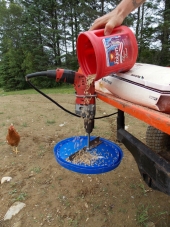




 1
1




"You must be the change you want to see in the world." "First they ignore you, then they laugh at you, then they fight you, then you win." --Mahatma Gandhi
"Preach the Gospel always, and if necessary, use words." --Francis of Assisi.
"Family farms work when the whole family works the farm." -- Adam Klaus









Owner, Etta Place Cider
 1
1




Ann Torrence wrote:For two seasons we've been doing a chop and drop mow in our beat-up old mixed alfalfa pasture, mowing about once a month. We planted about 200 apple and pear trees in the field, not clearing anything around the trees beyond about a 1'. Later we went back and expanded a gravel zone around each tree to ease the mowing and thwart the voles. Voles will girdle young fruit trees. If you don't cut the alfalfa occasionally, it will get really thick stems. Alfalfa is our primary nitrogen fixer for this area right now. In two years, we can already see the soil getting darker.
We do leave some uncut each time to flower for the bees. In the fall, we mow everything except one patch that we let get really tall for vole habitat. Then we put our cat out there for a few days.
In the area we put the garden, I do the same, chop and drop. There's no grubbing an alfalfa plant out with a hoe anyway, so I just accept them. I do weed out the seedlings though.
If the farmer is willing, he might keep mowing, just not rake and bale, if you don't have the equipment. I can't find anyone here to do it, they are all just too busy, so we had to get mowing equipment.
 but then I only have 1 acre to mow, in fact even less now that the earthworks have been done
but then I only have 1 acre to mow, in fact even less now that the earthworks have been done










Levente Andras wrote:My "mowing equipment" is a good 50-year old scythe
but then I only have 1 acre to mow, in fact even less now that the earthworks have been done
Owner, Etta Place Cider

|
I'm all tasted up for a BLT! This tiny ad wants a monte cristo!
Homestead Pigs Course
https://permies.com/wiki/365748/Homestead-Pigs
|



